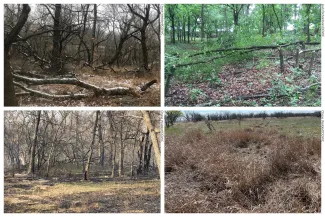
Deer bedding areas can be a great addition to other habitat management practices to attract and hold deer more closely on a single property. The type of cover available for bedding areas is influenced by many factors, including the terrain and location of the property within the state. Things to consider when choosing a location for a deer bedding area are wind direction to planned hunting locations, the ability of the location to hide deer, and distance to food. These bedding areas ideally should be 10 to 40 acres in size, or more for larger properties.
If you use trail cameras, set them on travel corridors and trails entering and exiting the bedding area, not in the area itself. The less human disturbance the safer and more comfortable the deer will feel, which is nearly a must if you hope to have mature bucks utilizing the bedding area. Does can tolerate human disturbance and being bumped off their beds to a much greater degree. However, we all know how mature bucks are, all it takes is one slip up and a mature buck will go nocturnal or totally leave an area.

Bedding for white-tailed deer can come in the form of blown down trees and limbs (top left photo), hinge-cut trees that offer both cover and browse (top right photo), a felled tree (bottom left photo), or a stand of native grass (bottom right photo).
For mature stands of timber in eastern Oklahoma, one great option to enhance bedding capability is felling trees and leaving them lay. When doing this, take note of the tree species and the size or shape of the tree, as it may be a better option to leave it standing if it is a mast producing tree or a tree that could provide roosting areas for turkeys. If the timber is largely marketable and accessible, another good option is taking inventory and having an area logged to meet your goals while leaving 40-60% canopy coverage (if you take 100 steps through your timber, 40-60 of those should have clear sky above) and mast producing trees of different age classes while harvesting others to thin the forest. This will allow a great deal more sunlight to the forest floor and promote native grasses and forbs and successional growth which deer will utilize as bedding areas.
A good logger will clean up and remove all slash and nonmarketable timber on the ground. But for bedding purposes, it may be beneficial to leave some treetops and slash laying which will give deer a place to nestle into and feel more secure. In these more timbered areas, prescribed fire is necessary to help keep the vegetation in an early successional stage.
For less mature wooded areas, hinge cutting trees to make a tent-like area would be a good option. Because hinge-cut trees remain alive, this option not only provides cover but also allows deer to browse the lowered canopy of the trees that may have previously been out of reach.
In western parts of the state, timber is obviously rather limited, however deer bedding needs can still be addressed. Deer will still use areas of woody cover such as plum thickets or sumac stands for bedding, and these patches of woody cover also make great upland bird habitat. Additionally deer will use dense stands of tall grass, like big bluestem or switchgrass. Johnson grass can also provide the dense bedding habitat that deer are looking for, but Johnson grass at that density reduces all other beneficial wildlife uses and overall habitat would be better served by working to reduce/eliminate Johnson grass and manage more for native, tall bunch grasses.
Now let's take a minute to discuss a common misconception. Many landowners and hunters believe that dense stands of cedar trees provide good bedding or escape cover for deer. It is true that sometimes deer will use these areas, but it is far from a preferred cover for them. Cedar trees often have limbs coming off the trunk as low as a foot off the ground. This gives no place or way for a deer to actually get underneath branches to shelter them from rain or snow. Additionally cedar trees can form such a dense canopy that no other herbaceous vegetation grows underneath, creating a moonscape of habitat. So do your deer a favor, clear out those cedar trees and replace them with grass, shrubs, or get a start on some hardwoods.